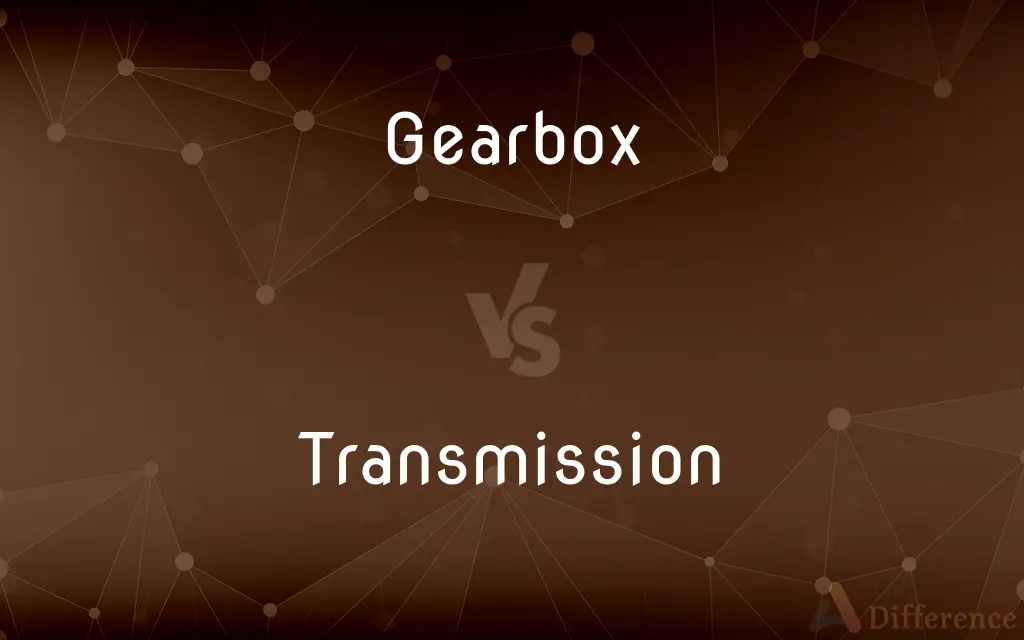Gearbox vs. Transmission — What's the Difference?
By Fiza Rafique & Maham Liaqat — Updated on March 27, 2024
A gearbox is a component within a transmission system that adjusts torque and speed through gear ratios, while a transmission encompasses the entire system managing power from the engine to the wheels, including the gearbox.

Difference Between Gearbox and Transmission
Table of Contents
ADVERTISEMENT
Key Differences
A gearbox is a crucial part of the vehicle's transmission system, specifically designed to modify the torque and speed sent to the wheels from the engine using different gear ratios. It allows the vehicle to accelerate and operate efficiently at various speeds. On the other hand, the transmission refers to the entire system that transmits power from the engine to the drive axle. This system includes not just the gearbox but also the clutch, differential, and driveshaft, working together to manage vehicle speed and torque.
The gearbox enables drivers to select gear ratios manually in manual transmissions or automatically in automatic transmissions, influencing how power is distributed to the wheels. Whereas the transmission system uses these selections to adjust the vehicle's performance accordingly, balancing speed, power, and fuel efficiency across different driving conditions.
In manual transmissions, the gearbox's role is more hands-on for the driver, requiring manual shifting of gears based on speed and load. In contrast, automatic transmissions manage gear changes themselves, with the system automatically adjusting the gears based on the vehicle's speed and engine load without driver input.
Gearboxes can be complex mechanical devices that require precise engineering to ensure smooth gear changes and optimal performance. Transmission systems, incorporating the gearbox, need to integrate electronic, hydraulic, and mechanical components seamlessly to deliver power efficiently from the engine to the wheels.
Choosing between a vehicle with a particular type of gearbox or transmission system often comes down to driving preferences, performance needs, and fuel efficiency. Vehicles with manual gearboxes often provide more control over the vehicle's performance and can be more fuel-efficient, while automatic transmissions offer ease of use and comfort, especially in stop-and-go traffic.
ADVERTISEMENT
Comparison Chart
Definition
A mechanism for changing gear ratios.
The entire system that transmits power from the engine to the wheels.
Components
Gears and gear trains.
Gearbox, clutch, driveshaft, differential.
Function
Adjusts vehicle speed and torque via gear ratios.
Manages the delivery of power to the drive axle.
User Interaction
Manual shifting in manual transmissions; automatic in automatic transmissions.
Can be manual or automatic, depending on the type.
Complexity
Mechanically complex, focusing on gear changes.
Integrates mechanical, electronic, and hydraulic components.
Key Benefit
Allows for precise control of vehicle speed and efficiency.
Facilitates smooth power transition and efficiency in vehicle performance.
Typical Use
Part of both manual and automatic transmission systems.
Essential in all types of vehicles for power management.
Compare with Definitions
Gearbox
Mechanism in manual transmission requiring driver engagement.
Shifting the gearbox smoothly requires practice.
Transmission
Essential for vehicle speed control and efficiency.
Regular maintenance of the transmission ensures the vehicle's longevity.
Gearbox
A set of gears for varying torque and speed.
The car's gearbox ensures optimal performance at high speeds.
Transmission
Includes mechanisms like the clutch and differential.
The transmission's efficiency is crucial for smooth driving.
Gearbox
Integral part of an automatic transmission, changes gears based on speed.
The automatic gearbox adjusts the gear ratio without driver input.
Transmission
Automatic versions provide ease of use.
The car's automatic transmission switches gears seamlessly.
Gearbox
A component that can be optimized for fuel efficiency.
The vehicle's gearbox was engineered to enhance fuel economy.
Transmission
The system transferring engine power to the wheels.
A problem with the transmission can affect the car's overall performance.
Gearbox
Can be designed for specific performance objectives.
The racing car's gearbox is tuned for quick acceleration.
Transmission
Can be manual, requiring driver gear shifts.
Manual transmission vehicles often have better fuel economy.
Gearbox
See transmission.
Transmission
The action or process of transmitting something or the state of being transmitted
The transmission of the virus
Gearbox
A protective casing for a system of gears.
Transmission
The mechanism by which power is transmitted from an engine to the axle in a motor vehicle
A three-speed automatic transmission
Gearbox
An enclosed gear train.
Transmission
The act or process of transmitting.
Gearbox
That part of a car's transmission containing the train of gears, and to which the gear lever is connected.
Transmission
The fact of being transmitted.
Gearbox
The metal casing in which a train of gears is sealed.
Transmission
Something, such as a message, that is transmitted.
Gearbox
The shell (metal casing) in which a train of gears is sealed
Transmission
An assembly, as in a motor vehicle, that transmits power from an engine to a driving axle, usually having a manually or automatically adjustable mechanism to control the balance of power and speed. Also called gearbox.
Transmission
The sending of a signal, picture, or other information from a transmitter.
Transmission
The act of transmitting, e.g. data or electric power.
Transmission
The fact of being transmitted.
Transmission
Something that is transmitted, such as a message, picture, or a disease; the sending of such a thing.
Transmission
(biology) The passage of a nerve impulse across synapses.
Transmission
(automotive) An assembly of gears through which power is transmitted from the engine to the driveshaft in a motor car / automobile; a gearbox.
Transmission
(legal) The right possessed by an heir or legatee of transmitting to his successor(s) any inheritance, legacy, right, or privilege, to which he is entitled, even if he should die without enjoying or exercising it.
Transmission
(medicine, biology) The passing of a communicable disease from an infected host individual or group to a conspecific individual or group.
Transmission
The act of transmitting, or the state of being transmitted; as, the transmission of letters, writings, papers, news, and the like, from one country to another; the transmission of rights, titles, or privileges, from father to son, or from one generation to another.
Transmission
The right possessed by an heir or legatee of transmitting to his successor or successors any inheritance, legacy, right, or privilege, to which he is entitled, even if he should die without enjoying or exercising it.
Transmission
The mechanism within a vehicle which transmits rotational power from the engine to the axle of the wheel propelling the vehicle; it includes the gears and gear-changing mechanism as well as the propeller shaft.
Transmission
The process or event of sending signals by means of a radio-frequency wave from an electronic transmitter to a receiving device.
Transmission
The act of sending a message; causing a message to be transmitted
Transmission
Communication by means of transmitted signals
Transmission
The fraction of radiant energy that passes through a substance
Transmission
An incident in which an infectious disease is transmitted
Transmission
The gears that transmit power from an automobile engine via the driveshaft to the live axle
Common Curiosities
What's the difference between manual and automatic transmissions?
Manual transmissions require the driver to shift gears, while automatics manage gear changes themselves.
Why do sports cars often use manual transmissions?
For greater control over the vehicle's performance and speed.
Can a vehicle operate without a gearbox?
No, a gearbox is essential for changing speeds and managing engine power efficiently.
Is the gearbox more important than the transmission?
The gearbox is a critical component of the transmission system; neither is more important as they work together.
Can I switch from automatic to manual transmission in my car?
It's technically possible but complex and costly, involving significant modifications.
What's the main function of a gearbox?
To adjust vehicle speed and torque through different gear ratios.
What are the signs of transmission problems?
Warning signs include slipping gears, delays in acceleration, and strange noises.
How does a transmission work?
It transmits power from the engine to the drive axle, managing vehicle speed and torque.
What's a dual-clutch transmission?
It's an automatic transmission that uses two clutches for smooth gear changes.
Can transmissions be repaired or must they always be replaced?
Many transmission issues can be repaired, though severe problems might require replacement.
How do gear ratios in a gearbox work?
Gear ratios determine how much the engine's output is reduced or multiplied before it reaches the wheels.
How often should transmission fluid be changed?
It varies by vehicle and transmission type, but generally between 30,000 to 60,000 miles.
What maintenance does a transmission need?
Regular fluid changes, filter replacements, and inspections to prevent issues.
What's the role of the differential in a transmission system?
It allows the wheels to rotate at different speeds, essential for turning.
How does the gearbox affect fuel efficiency?
By ensuring the engine operates within an optimal power band, enhancing efficiency.
Share Your Discovery

Previous Comparison
Maltodextrin vs. Dextrin
Next Comparison
Aggradation vs. DegradationAuthor Spotlight
Written by
Fiza RafiqueFiza Rafique is a skilled content writer at AskDifference.com, where she meticulously refines and enhances written pieces. Drawing from her vast editorial expertise, Fiza ensures clarity, accuracy, and precision in every article. Passionate about language, she continually seeks to elevate the quality of content for readers worldwide.
Co-written by
Maham Liaqat













































